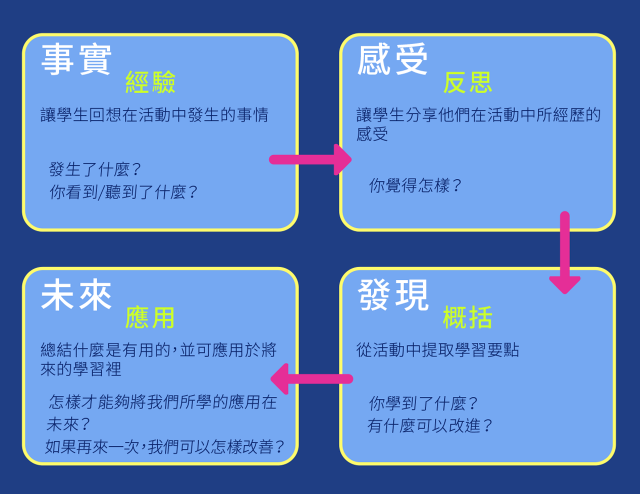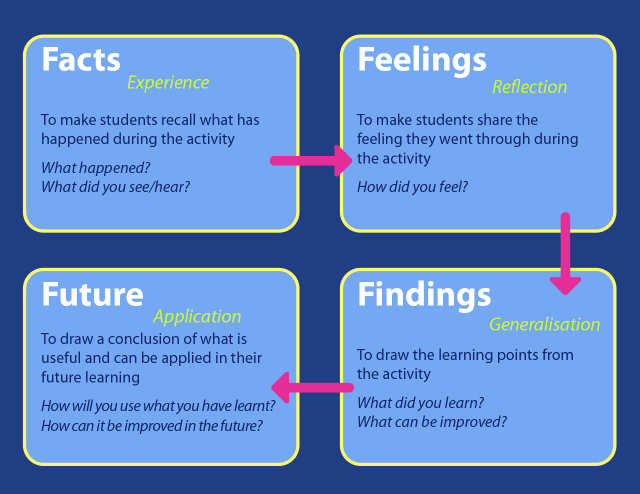運用解說讓學生主動學習
什麼是解說?
「解說被視為促進知識學習和記憶、提高技能、加強對自我能力的認知,以及改變態度的的好方法」(教學中心翻譯)(Chronister 和 Brown, 2012) 。 這個概念已經在心理學和臨床研究中非常普及。在課堂上,解說是引導學生反思學習經歷的過程,將個人的想法和一些實情貫穿起來,從而加深他們的理解。正如James Raths教授(1987)表示,解說使學生能夠重新審視和反思他們所經歷的事物中的意義,並可以幫助他們整合及保存新的知識。
解說策略
作為教師,我們可能會因為忙於日常的教務、講課、簡報設計及批改習作等工作,而忽略解說對學生學習過程的重要性。Raths(1987)很貼切地解釋了解說的好處:「解說讓學生能夠自由地組織、比較、分類、評估、總結或分析經驗。解說過程最終把彼此相關的『意義』連繫起來。」 (教學中心翻譯)。
教師可以使用各種活動和工具來幫助學生通過回想和反思他們的經歷來建構意義。教師可以利用一些簡單的問題,例如「你看到/想到/想知道什麼?」和「讓你印象最深刻的是什麼?」等來引起學生的反思。除此之外,撰寫日記可讓學生記錄他們對某事件或經歷的反應和感受。學生亦可揀選一張圖片或一段音樂來表達他們的感受。如果想嘗試非言語的表達方式,繪畫或跳舞都可以幫助學生表達自己的感受。
4F模式
由Roger Greenway博士開發的「4F模式」(包含了事實、感受、發現和未來四個重要提問步驟)是一個利用解說四部曲而產生的主動回顧模式。「4F模式」籍著四個重要提問步驟讓學生從直接感受、描繪該經驗,到深入反思該經驗而總結出啟示。這四個重要提問步驟創造富邏輯性的思考流程及方向,提高學生參與度並把經驗轉化成學習。 在每一個步驟中,帶領解說者可以提出能突顯學習活動進程的問題,以促使學生積極審視他們的經歷和看法。該模式闡述如下:

4F解說模式
(圖像由教學中心提供,2018)
解說是促進批判性推理和反思學習過程的有效工具。適當地使用解說可以引導學生回顧和重整他們學到的知識,從而達到促進學習經驗的目的。藉著解說,教師「不僅教導學生事實,而且讓學生明理」(Rahts,1987)。
參考文獻:
Chronister, C., & Brown, D. (2012). Comparison of simulation debriefing methods. Clinical Simulation in Nursing, 8(7), e281-e288.
Raths, J. (1987). Enhancing Understanding Through Debriefing. Educational Leadership, 45(2), 24-27.
Using Debriefing for Active Learning
What is debriefing?
“Debriefing has been credited with fostering better knowledge acquisition and retention, skill improvements, heightened perceptions of self-competence, and attitudinal changes among other benefits" (Chronister & Brown, 2012). This concept has been popularised in psychology and clinical studies. In classrooms, debriefing is a process of guiding students to reflect on their learning experiences, blending personal meaning to them in order to deepen their understanding. As Professor James Raths (1987) stated that it enabled students to re-examine and reflect on the meaning of their experience and could help them integrate and retain new learning.
Debriefing Strategies
We, as teachers may be overwhelmed with daily teaching routines, giving lectures, designing PowerPoints, marking students' work, etc., and we may forget the importance of the debriefing process to students' learning. The benefits of debriefing is well explained by Raths (1987), “Debriefing gives students relatively free rein to organise, compare, classify, evaluate, summarise or analyse an experience. The product of the debriefing process is an articulated sense of ‘meaning'.”
There are various kinds of activities and tools teachers can use to help students construct meaning through recalling and reflecting on their experience. Some inquiring questions as simple as “What did you see/think/wonder?” and “What impressed you most?” could be asked to promote students' reflection. Apart from these, writing logs allows students to document their reactions and feelings to a particular event or experience. Choosing a picture or a piece of music to describe their feelings provides students an alternative way to express and explain themselves. Drawing or dancing is a non-verbal way that helps students convey their feelings to others.
4F Model for Debriefing
The “4F Model” (namely facts, feelings, findings and future), is an active reviewing model using a process of debriefing steps developed by Dr Roger Greenway. By pinching the elements of the four steps from directly observing the experience, the “4F Model”engages students/learners in a deeper reflection of the implication of the experience. The sequence of four aspects create a logical flow and direction for debriefing and is considered as one of the most applied debriefing strategies to improve engagement and facilitate learning from experience. In each step, the person who facilitates the debriefing can ask questions which highlight the evolution of the learning activity to prompt students actively review their experience and perceptions. The model is illustrated as follows:

4 F Models for Debriefing
(Image courtesy of CLT, 2018)
Debriefing is an effective tool to foster the critical reasoning and reflective learning processes. The proper use of debriefing could help facilitate learning from experience. By guiding students to recall and reconstruct what they have learnt, teachers can “instruct not only for facts, but for understanding” (Rahts, 1987).
References:
Chronister, C., & Brown, D. (2012). Comparison of simulation debriefing methods. Clinical Simulation in Nursing, 8(7), e281-e288.
Raths, J. (1987). Enhancing Understanding Through Debriefing. Educational Leadership, 45(2), 24-27.
